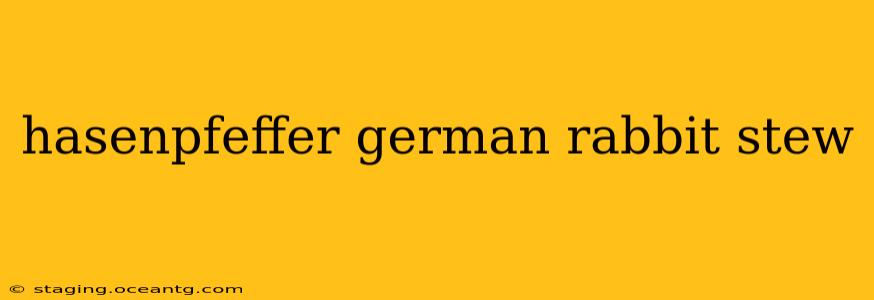Hasenpfeffer, a traditional German rabbit stew, is a dish steeped in history and rich in flavor. Far from the simple rabbit stew you might imagine, Hasenpfeffer boasts a complex preparation involving marinating the rabbit in wine and vinegar, resulting in a tender, subtly tangy, and deeply satisfying meal. This article will explore the nuances of this classic dish, answering frequently asked questions and providing insights into its preparation and cultural significance.
What is Hasenpfeffer?
Hasenpfeffer literally translates to "hare pepper," though it's more commonly made with rabbit. The "pepper" refers not to the spice itself, but rather to the peppery bite imparted by the vinegar and wine marinade. This isn't a quick stew; it's a culinary journey that rewards patience with a depth of flavor unmatched by simpler preparations. The long marinating process tenderizes the rabbit meat, infusing it with a complex, slightly tart profile that makes it a unique and memorable experience.
What kind of rabbit is used for Hasenpfeffer?
While wild hare was traditionally used, modern recipes predominantly utilize domestic rabbit. The key is to source high-quality rabbit meat; its tenderness is crucial to the final dish's success. Look for rabbit that's properly butchered, free of excessive fat, and ideally from a reputable butcher or farmer.
How long does it take to marinate rabbit for Hasenpfeffer?
The marinating time is a cornerstone of Hasenpfeffer. Most recipes call for a minimum of 12 hours, often up to 24 or even 48 hours. This extended marination allows the vinegar and wine to thoroughly penetrate the rabbit meat, breaking down tough fibers and infusing it with their characteristic tang. The longer the marinate, the more tender and flavorful the final dish will be.
What are the traditional ingredients in Hasenpfeffer?
Beyond the rabbit, the classic Hasenpfeffer recipe hinges on a robust marinade. This typically includes red wine (often a dry red like Pinot Noir or Spätburgunder), vinegar (typically red wine vinegar, but apple cider vinegar can be substituted), onions, juniper berries, peppercorns (both black and white), bay leaves, and sometimes cloves. These ingredients combine to create a complex, savory, and slightly sour base for the stew.
What are some variations of Hasenpfeffer?
While the core ingredients remain consistent, variations in Hasenpfeffer exist across different regions and families. Some recipes incorporate other aromatics like thyme or rosemary. The cooking method can also vary; some prefer braising, while others opt for slow-cooking techniques. The inclusion of vegetables like carrots, potatoes, or mushrooms is also a common variation, adding depth and texture to the stew.
Is Hasenpfeffer difficult to make?
While the extended marinating time requires planning, the actual preparation of Hasenpfeffer is not overly complex. The process involves marinating the rabbit, then browning it, and finally simmering it in the marinade with added vegetables (optional). The key to success lies in the quality of the ingredients and patience during the marinating and cooking process.
Where can I find a good Hasenpfeffer recipe?
Numerous excellent Hasenpfeffer recipes can be found online and in cookbooks focusing on German cuisine. Searching for "authentic Hasenpfeffer recipe" will yield numerous options. Remember to pay attention to the marinating times and the quality of the ingredients for the best results.
Conclusion
Hasenpfeffer is more than just a stew; it's a culinary testament to German tradition and a celebration of slow-cooked flavors. By understanding the importance of the long marinade and the nuances of the recipe, you can create a memorable dish that showcases the rich culinary heritage of Germany. The patience invested in preparing Hasenpfeffer is richly rewarded with a tender, flavorful, and truly authentic German experience.
